
|
Vegetative stage (Sowing to square leaf formation) |
Groundnut leaf miner: Aproaerema modicella
| Parts affected |
Symptoms
|
Management
|
Image
|
| Panicles, leaves and stem |
• Young larvae initially mine into the leaflets, feed on the mesophyll and form small brown blotches on leaf.
• Later stages larvae web the leaflets together and feed on them and remains within the folds.
• Severely attacked field looks "burnt" from a distance.
|
Cultural method :
• Plant cowpea or soybean as trap crop.
• Crop rotation with non leguminous crop in regions having severe recurring problem.
• Avoid crop rotation of groundnut with soybean and other leguminous crops.
• Use resistant/tolerant varieties.
Mechanical method:
• Collect and destroy egg masses and early instars larvae.
• Install pheromone trap @ 5/ha for mass trapping.
• Spray neem based formulation @ 5%.
Biological method:
• Release Trichogramma Chilonis @ 50000/ha twice (7-10 days interval)
• Conserve the natural enemies namely, spiders, long horned grasshoppers, praying mantis, robber fly, ants, green lace wing, damsel flies/dragon flies, flower bugs, shield bugs, lady bird beetles, ground beetle, predatory cricket, earwig, braconids, trichogrammatids, NPV, green muscular fungus.
• Mulching of rice straw reduces leaf miner incidence and increase in percentage parasitism.
• Intercropping groundnut with Pennisetum glacum (Napier grass) enhanced the parasitism of Goniozus spp. on leaf miner.
Chemical method:
• Apply insecticides if the insect population crosses the economic threshold level (ETL).
• For effective control apply insecticide at 45 and 70 days after planting.
• Carbaryl 50WP 0.2 per cent spray was found to be most economical for controlling this pest; or Spray Quinalphos 25 EC 2ml or Methyldemeton 25 EC 1.6ml or Dimethoate 30 EC 2ml /lit of water. |
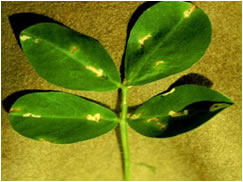 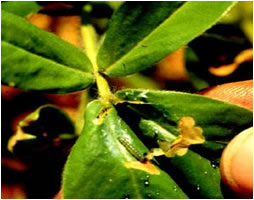 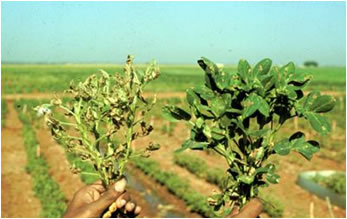 |
| |
| |
Aphids: Aphis craccivora
| Parts affected |
Symptoms
|
Management
|
Image
|
| Panicles, leaves and stem |
• Nymphs and adults suck sap from tender growing shoots, flowers, causes stunting and distortion of the foliage and stems.
• They excrete honeydew which invites sooty molds development leads to black coating on leaves.
• Aphids transmits Groundnut stripe virus and groundnut rosette virus complex.
|
Cultural method :
• Adopt Timely sowing of the crop.
• Cultivate varieties having dense hairs and with stiff leaves.
Mechanical method
• Handpicking and destruction of various insect stages and the affected plant parts.
Biological method:
• Seed treatment with Trichoderma viride @ 4 gm/kg seed.
• Release of Cheilomenes sexmaculata @ 1250/ha.
• Conserve bio control agents like flower bugs (anthocorids), lady bird beetles (coccinellids), praying mantis, hover flies (syrphids), green lace wing (chrysopids), long horned grass hoppers and spiders.
• Apply NSKE 5% (neem seed kernel extract) to control sucking pests.
Chemical method:
• Apply insecticides if the insect population crosses the economic threshold level (ETL).
• Young crop may be applied with Monochrotophos 36SL 600ml/ha or Dimethate 30 EC @ 650ml/ha in 600 liter water.
• Dusting of Endosulphan 4% dust at 1 kg a.i./ha would be effective in controlling aphids. |
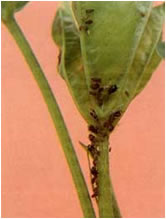   |
| |
| |
Jassids: Empoasca kerri
| Parts affected |
Symptoms
|
Management
|
Image
|
| Panicles, leaves and stem |
• Both nymphs and adults suck sap from central surface of leaves, inject toxins in plant results in whitening of veins and chlorotic patches especially at the tips of leaflets, in a typical 'V' shape.
• Heavily attacked crop looks yellow and gives a scorched appearance known as 'hopper burn'.
|
Cultural method :
• Adopt timely sowing of the crop.
• Maintain field sanitation.
• Grow tolerant varieties like Girnar 1
• Follow crop rotation with non host crop.
• Intercropping with pearl millet
• Avoid groundnut-castor inter crop, it increases the infestation.
• Irrigate once to avoid prolonged mid season drought to prevent pre-harvest.
Mechanical method:
• Collect and destroy the affected parts of the plant.
Biological method
• Conserve bio agents like praying mantis, long horned grass hoppers, dragon flies spiders, green muscardine fungus.
Chemical method:
• Apply insecticides if the insect population crosses the economic threshold level (ETL).
• Spray dimethoate 30EC @ 650ml/ha or Monochrotophos 36SL @ 600ml/ha in 600liter water.
|
  |
| |
| |
Thrips: Scirtothrips dorsalis, Scirtothrips dorsalis, Frankliniella schultzei
| Parts affected |
Symptoms
|
Management
|
Image
|
| Panicles, leaves and stem |
• Nymphs and adults lacerate the surface of the leaflets and suck the oozing sap resulting in white patches on lower surface of the leaves and distortion of young leaflets.
• Severe infestations cause stunted plants.
• Thrips transmits peanut bud necrosis.
|
Cultural method :
• Grow tolerant varieties like ALR 3, Robut 33-1, Kadiri 3 and ICGS 86031
• Uproot and destroy severely infected plants.
Biological method
• Conserve natural enemies namely, flower bugs (anthocorids), lady bird beetles (coccinellids), praying mantis, green lace wing (chrysopids), long horned grass hoppers, dragon flies and spiders.
Chemical method:
• Apply safe chemical insecticides at recommended doses only if the insect population crosses the ETL.
• Spray Monochrotophos 36SL 600 ml/ha or Dimethoate 30 EC 650ml/ha or Methyldemeton 25 EC 600 ml in 600 lit of water.
• Spray per acre monocrotophos 320ml mixed with neem oil 1lit and 1kg soap powder mixed in 200lit of water twice at 10days interval.
|
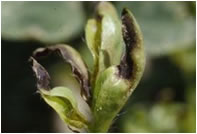   |
| Groundnut leaves affected by Thrips |
| |
Groundnut bud borer: Anarsia ephippias
| Parts affected |
Symptoms
|
Management
|
Image
|
| Panicles, leaves and stem |
• The larva bores into the terminal buds and shoots and tip of the stem.
•The tender leaflets emerging from central spindle will show shot-hole symptoms initially.
•In severe infestation emerging leaflets will have only the midribs or several oblong feeding holes.
|
• Neem oil 3 per cent and leaf extract of Vitex negumdo (nochi) 5 per cent were also effective against this pest.
• The hymenopteran parasitoids, Bracon gelechiiae and Brachymeria sp cause parasitism up to 24 per cent on larvae.
• Spraying of monocrotophos 36SL 0.5 per cent (1.5 ml/lit) was found to be more effective in controlling the bud borer.
|
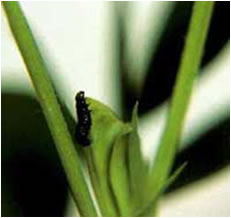 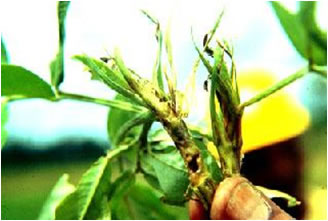 |
| |
| |
Aspergillus crown rot
| Parts affected |
Symptoms
|
Management
|
Image
|
| Panicles, leaves and stem |
•Pre -emergence rotting and killing of seeds.
• Post-emergence infection causes death and rapid decay of seedlings.
• Young plants collapse and die soon after emergence due to rotting of elongating hypocotyl.
• Collar region become dark brown & shredded.
• In mature plants large lesions develop on stem just below the soil surface & then spread upward along the branches causing wilting & death.
• The fungus sporulates on the surface of mature pods resulting of black sooty spores. |
•Follow Crop rotation.
• Remove and destroy previous season's infested crop debris in the field.
• Seed treatment with Trichoderma viride/T.harizanum @ 4 g/kg seed and soil application of Trichoderma viride/T.harizanum @25-62.5kg/ha, preferably in conjunction with organic amendments such as castor cake or neem cake or mustard cake @ 500 kg/ ha.
• Seed treatment with 3 g thiram/ kg seed is recommended.
|
  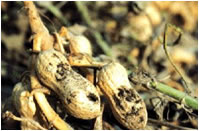 |
| Aspergillus crown rot affected plant and pods |
| |
Charcoal Rot: Macrophomina phaseoli
| Parts affected |
Symptoms
|
Management
|
Image
|
| Panicles, leaves and stem |
• Reddish-brown water-soaked lesion appears on stem just above the soil level.
• The lesion spreads upwards on the stem and down into the roots and causes death of the plants.
• The dead tissue is covered with abundant sclerotia.
|
• Deep ploughing should be followed to bury the crop residues.
• Seed treatment with Thiram @ 5 g per kg of seed.
• Soil application of Brassicol before sowing at the rate of 10-15 kg per hectare.
|
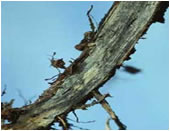 |
| Charcoal Rot affected root |
| |
Sclerotium Rot or stem rot:Sclerotium rolfsii.
| Parts affected |
Symptoms
|
Management
|
Image
|
| Panicles, leaves and stem |
• The affected plant parts show the development of the white thread-like fungal growth near the soil surface or just below the ground level.
• The affected plant parts later turn brown and small round bodies of about the size of a mustard seed are produced on the surface of affected tissue.
• The leaves turn yellow and then brown and later desiccate.
|
• Collect and burn the affected plant debris.
• Seed treatment with 3% Brassicol.
• Soil application of Brassicol before sowing at the rate of 10-15 kg per hectare.
|
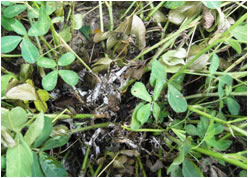 |
| Sclerotium Rot or stem rot affected plant with white mycelial growth |
| |
Early leaf spot : Cercospora arachidicola
| Parts affected |
Symptoms
|
Management
|
Image
|
| Panicles, leaves and stem |
• Infection starts about 1 month after sowing.
• Small chlorotic spots appear on leaflets, with time they enlarge and turn brown to black and become sub circular shape on upper leaf surface.
• On lower surface of leaves light brown colouration is seen.
• Lesions also appear on petioles, stems, stipules.
• In severe cases several lesions coalesce and result in premature senescence of affected plant.
• Severe disease attack leads to shedding of leaflets resulting in premature ageing of the crop.
|
Cultural method :
• Grow tolerant varieties wherever early leaf spot incidence is severe.
• Intercropping pearl millet or sorghum with groundnut (1 : 3).
• Crop rotation with non-host crops preferably cereals.
• Deep burying of crop residues in the soil, and removal of volunteer groundnut plants to reduce the primary source of infection.
Botanicals:
• Foliar application of aqueous neem leaf extract (2-5%) or 5% neem seed kernel extract at 2 weeks interval 3 times starting from 4 weeks after planting is good.
Chemical method :
• Spray carbendazim 0.1% or mancozeb 0.2% or chlorothalonil 0.2%.
|
 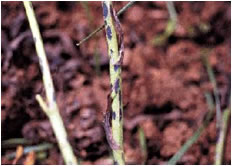 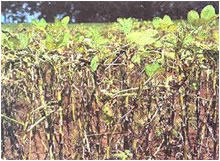 |
| Early spot on leaves with typical yellow hollow, affected stem and field |
| |
Nitrogen
| Parts affected |
Symptoms
|
Management
|
Image
|
| Leaves |
•yellow undersized leaves
•severe retardation of growth
•twigs become yellow in color
•fruits smaller and mature early
•leaves small with general yellowing
|
• Application of recommended nitrogenous fertilizers (69kg of Urea/acre) or foliar application of Urea 20gm-40gm/lit water at fortnightly intervals. |
 |
| Reproductive stage (Flowering, pollination and fertilisation) |
| 1.Flowering, pollination and fertilisation |
Groundnut leaf miner: Aproaerema modicella
| Parts affected |
Symptoms
|
Management
|
Image
|
| Panicles, leaves and stem |
• Young larvae initially mine into the leaflets, feed on the mesophyll and form small brown blotches on leaf.
• Later stages larvae web the leaflets together and feed on them and remains within the folds.
• Severely attacked field looks "burnt" from a distance.
|
Cultural method :
• Plant cowpea or soybean as trap crop.
• Crop rotation with non leguminous crop in regions having severe recurring problem.
• Avoid crop rotation of groundnut with soybean and other leguminous crops.
• Use resistant/tolerant varieties.
Mechanical method:
• Collect and destroy egg masses and early instars larvae.
• Install pheromone trap @ 5/ha for mass trapping.
• Spray neem based formulation @ 5%.
Biological method:
• Release Trichogramma Chilonis @ 50000/ha twice (7-10 days interval)
• Conserve the natural enemies namely, spiders, long horned grasshoppers, praying mantis, robber fly, ants, green lace wing, damsel flies/dragon flies, flower bugs, shield bugs, lady bird beetles, ground beetle, predatory cricket, earwig, braconids, trichogrammatids, NPV, green muscular fungus.
• Mulching of rice straw reduces leaf miner incidence and increase in percentage parasitism.
• Intercropping groundnut with Pennisetum glacum (Napier grass) enhanced the parasitism of Goniozus spp. on leaf miner.
Chemical method:
• Apply insecticides if the insect population crosses the economic threshold level (ETL).
• For effective control apply insecticide at 45 and 70 days after planting.
• Carbaryl 50WP 0.2 per cent spray was found to be most economical for controlling this pest; or Spray Quinalphos 25 EC 2ml or Methyldemeton 25 EC 1.6ml or Dimethoate 30 EC 2ml /lit of water. |
   |
| |
| |
Aphids: Aphis craccivora
| Parts affected |
Symptoms
|
Management
|
Image
|
| Panicles, leaves and stem |
• Nymphs and adults suck sap from tender growing shoots, flowers, causes stunting and distortion of the foliage and stems.
• They excrete honeydew which invites sooty molds development leads to black coating on leaves.
• Aphids transmits Groundnut stripe virus and groundnut rosette virus complex.
|
Cultural method :
• Adopt Timely sowing of the crop.
• Cultivate varieties having dense hairs and with stiff leaves.
Mechanical method
• Handpicking and destruction of various insect stages and the affected plant parts.
Biological method:
• Seed treatment with Trichoderma viride @ 4 gm/kg seed.
• Release of Cheilomenes sexmaculata @ 1250/ha.
• Conserve bio control agents like flower bugs (anthocorids), lady bird beetles (coccinellids), praying mantis, hover flies (syrphids), green lace wing (chrysopids), long horned grass hoppers and spiders.
• Apply NSKE 5% (neem seed kernel extract) to control sucking pests.
Chemical method:
• Apply insecticides if the insect population crosses the economic threshold level (ETL).
• Young crop may be applied with Monochrotophos 36SL 600ml/ha or Dimethate 30 EC @ 650ml/ha in 600 liter water.
• Dusting of Endosulphan 4% dust at 1 kg a.i./ha would be effective in controlling aphids. |
   |
| |
| |
Jassids: Empoasca kerri
| Parts affected |
Symptoms
|
Management
|
Image
|
| Panicles, leaves and stem |
• Both nymphs and adults suck sap from central surface of leaves, inject toxins in plant results in whitening of veins and chlorotic patches especially at the tips of leaflets, in a typical 'V' shape.
• Heavily attacked crop looks yellow and gives a scorched appearance known as 'hopper burn'.
|
Cultural method :
• Adopt timely sowing of the crop.
• Maintain field sanitation.
• Grow tolerant varieties like Girnar 1
• Follow crop rotation with non host crop.
• Intercropping with pearl millet
• Avoid groundnut-castor inter crop, it increases the infestation.
• Irrigate once to avoid prolonged mid season drought to prevent pre-harvest.
Mechanical method:
• Collect and destroy the affected parts of the plant.
Biological method
• Conserve bio agents like praying mantis, long horned grass hoppers, dragon flies spiders, green muscardine fungus.
Chemical method:
• Apply insecticides if the insect population crosses the economic threshold level (ETL).
• Spray dimethoate 30EC @ 650ml/ha or Monochrotophos 36SL @ 600ml/ha in 600liter water.
|
  |
| |
| |
Thrips: Scirtothrips dorsalis, Scirtothrips dorsalis, Frankliniella schultzei
| Parts affected |
Symptoms
|
Management
|
Image
|
| Panicles, leaves and stem |
• Nymphs and adults lacerate the surface of the leaflets and suck the oozing sap resulting in white patches on lower surface of the leaves and distortion of young leaflets.
• Severe infestations cause stunted plants.
• Thrips transmits peanut bud necrosis.
|
Cultural method :
• Grow tolerant varieties like ALR 3, Robut 33-1, Kadiri 3 and ICGS 86031
• Uproot and destroy severely infected plants.
Biological method
• Conserve natural enemies namely, flower bugs (anthocorids), lady bird beetles (coccinellids), praying mantis, green lace wing (chrysopids), long horned grass hoppers, dragon flies and spiders.
Chemical method:
• Apply safe chemical insecticides at recommended doses only if the insect population crosses the ETL.
• Spray Monochrotophos 36SL 600 ml/ha or Dimethoate 30 EC 650ml/ha or Methyldemeton 25 EC 600 ml in 600 lit of water.
• Spray per acre monocrotophos 320ml mixed with neem oil 1lit and 1kg soap powder mixed in 200lit of water twice at 10days interval.
|
   |
| Groundnut leaves affected by Thrips |
| |
Groundnut bud borer: Anarsia ephippias
| Parts affected |
Symptoms
|
Management
|
Image
|
| Panicles, leaves and stem |
• The larva bores into the terminal buds and shoots and tip of the stem.
•The tender leaflets emerging from central spindle will show shot-hole symptoms initially.
•In severe infestation emerging leaflets will have only the midribs or several oblong feeding holes.
|
• Neem oil 3 per cent and leaf extract of Vitex negumdo (nochi) 5 per cent were also effective against this pest.
• The hymenopteran parasitoids, Bracon gelechiiae and Brachymeria sp cause parasitism up to 24 per cent on larvae.
• Spraying of monocrotophos 36SL 0.5 per cent (1.5 ml/lit) was found to be more effective in controlling the bud borer.
|
  |
| |
| |
Bihar hairy caterpillar: Spilosoma (Diacrisia) obliqua
| Parts affected |
Symptoms
|
Management
|
Image
|
| Panicles, leaves and stem |
• Young larvae feed gregariously, mostly on under surface of the leaves.
• Feed on leaves and cause loss by defoliation.
• In severe cases only stems are left behind.
• It also feed on capsules in defoliated crop.
|
Cultural method :
• Pre-monsoon deep ploughing (two/three times) exposes the hibernating pupae to sunlight and predatory birds.
• Removal and destruction of alternate wild hosts which harbours the hairy caterpillars.
• Grow trap crops like cowpea, castor and jatropha on field bunds to attract the caterpillars.
• Irrigate once to avoid prolonged mid season drought to prevent pre-harvest infestation.
Mechanical method:
• Setting up bonfires on field bunds during night.
• Mass collection and destruction of eggs and just emerged caterpillars.
• Place the twigs and leaves of calotropis, jatropha and papaya around the field to trap grown up caterpillars and destroy them.
Biological method:
• Conserve the natural enemies namely, spiders, long horned grasshoppers, praying mantid, robar fly, ants, green lace wing, damsel flies/dragon flies, flower bugs, shield bugs, lady bird beetles, ground beetle, predatory cricket, earwig, braconids, trichogrammatids, NPV, green muscular fungus.
• Use of NPV (nuclear polyhedrosis virus) on cloudy days at 500 LE/ha.
• Spray Bacillus thuringiensis at 1 kg/ha where mulberry is not grown.
• Conserve the Barconids parasites.
Chemical method :
• Apply insecticides if the insect population crosses the economic threshold level (ETL).
• Dust Lindan 1.3% or Fanvalerate 0.4% 15.20 kg/ha, the early stage is easy to control.
• Form a deep furrow trench around the field and dust with two per cent methyl parathion to prevent the mass migration of hairy caterpillars.
• Spraying of quinalphos 25 EC (2 ml/lit), or chlorpyriphos 20 EC (2.5 ml/lit) or endosulfan 35 EC (2.0 ml/lit) recommended when the caterpillars are younger.
|
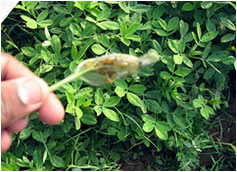 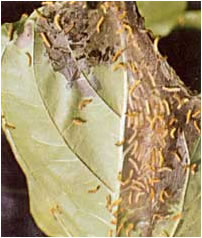 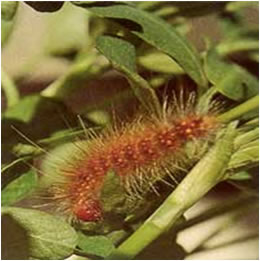  |
| |
| |
Tobacco caterpillar: Spodoptera litura
| Parts affected |
Symptoms
|
Management
|
Image
|
| Panicles, leaves and stem |
• Freshly hatched larvae feed gregariously by scraping the chlorophyll content of leaves and disperse soon.
• Larvae in later stages feed voraciously on the foliage at night, hides in the soil around base of the plants during day time.
• Sometimes the feeding is so heavy that only petioles and branches are left behind.
• In light soil area, caterpillar bores into the pods.
|
Cultural method :
• Deep summer ploughing.
• Early sowing to escape insect pest damage.
• Irrigate once to avoid prolonged mid season drought
• Planting castor or sunflower plants as trap crop for egg laying and destroying eggs or 1st stage larvae help in reducing the incidence.
• The sunflower act as bird perches as well.
Mechanical method:
• Install light trap.
• Two hand or mechanical weeding at 15-20 days after sowing.
• Use pheromone traps (5/ha) to monitor moth population.
• Install 10-12 bird perches per ha.
• Collection of egg masses/early instars larvae from trap crops.
Biological method:
• Conserve the natural bio control population of spiders, long horned grasshoppers, praying mantis, robar fly, ants, greenlace wing, damsel flies/dragon flies, flower bugs, shield bugs, lady bird beetles, ground beetle, predatory cricket, earwig, braconids, trichogrammatids, NPV, green muscular fungus.
• Release of Telenomus remus @ 50000/ha. 4 times (7-10 days interval) based on pheromone trap catching.
• Use SNPV @ 250 LE (6X 10^9/LE)/ha or B.t. @1 k.g/ha, when large number of egg masses and early instars larvae are noticed.
• Release Trichogramma chilonis @ 50000/ha. 2 times (7-10 days interval) based on on pheromone trap observation.
• Release of Bracon hebetor @ 5000/ha. two times at 7-10 days interval .
• Spray insect pathogenic fungus Nomuraea rileyi @10^13 spores/ha for controlling early instars.
• Release larval parasitoid apanteles africanus @ 5000/ha.
• Use 5% neem seed kernel extract on need basis.
Chemical method:
• Apply insecticides if the insect population crosses the economic threshold level (ETL).
• Apply Methyl parathion 2% dust @ 20 kg/ha or spraying of monochrotophos 36 SL or Quinolphos 25 EC @ 1500 ml or Endosulfan 35 EC @1250 ml or Trizophos 40EC @ 800 ml in 700-800 lit of water.
• Poison bait with monocrotophos 36 SL or carbaryl, rice bran, jaggery and water can be used to control the grown up larvae. |
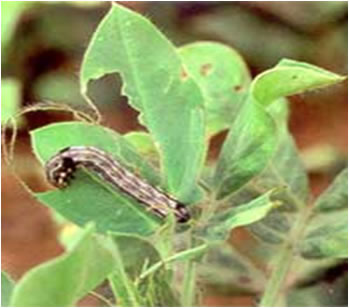 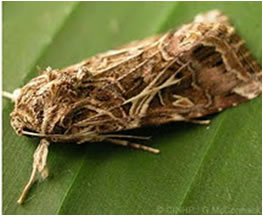 |
| |
| |
Red Hairy caterpillars: Amsacta albistriga, A. moorei
| Parts affected |
Symptoms
|
Management
|
Image
|
| Panicles, leaves and stem |
• Caterpillars cause defoliation of the crop as they are voracious feeders and often migrate from one field to another devastating whatever crops come their way.
After about 30-40 days of feeding the larvae burrow into soil, usually in the undisturbed soil of field or non-cropped areas and pupate.
|
Cultural method :
• Deep summer ploughing
• After kharif crop, the field should be ploughed to expose the pupae to predatory birds.
• Early sowing is done to escape insect pest damage.
• Plant Inter crop, one row of castor for every 5 or 6 rows of groundnut.
• Follow crop rotation with sorghum/pearl millet or maize.
• Vegetative traps utilising Jatropa (wild castor) or Ipomoea prevent the migration of the grown up larvae across fields.
• Irrigate once to avoid prolonged mid season drought to prevent pre-harvest infestation.
Mechanical method:
• Install of 12 light traps/ha or bonfire in endemic areas.
• Erection of light traps soon after monsoon for 20-45 days and collecting and killing of adult moths are found very effective.
• Collection and destruction of egg masses in the fields around light trap areas.
• Install 10-12 bird perches/ha.
• Two hand or mechanical weeding at 15-20 days after sowing.
Biological method:
• Spray A-NPV (2X 10 5 PIB/I) and Bacillus thuringiensis (Bt).
• Release of Bracon hebetor @ 5000/ha, two times at 7-10 days interval.
• Conserve dominant predators like Coccinella sp. and Minochilus sexmaculata and parasitoids like Chelonus spp.
• Conserve natural enemies namely, spiders, long horned grasshoppers, praying mantis, robar fly, ants, green lace wing, damsel flies/dragon flies, flower bugs, shield bugs, lady bird beetles, ground beetle, predatory cricket, earwig, braconids, trichogrammatids, NPV, green muscular fungus. (2X 105 PIB/I)
• Use 5% neem seed kernel extract on need basis.
• Inter cropping with pigeon pea, mung bean and soybean increases spiders population.
• Population of coccinellids is higher on groundnut with maize, mung bean and soybean and Chrysoperla spp. is higher with maize and soybean intercrops.
Chemical method:
• Apply insecticides if the insect population crosses the economic threshold level (ETL).
• Dusting of Methyl parathion 2% @ 25 to 30 kg/ha or Fanvalerate 0.4% @15-20 Kg/ha.
• Spray Endosulfan 35 EC or Quinalphos 25 EC @ 1250 ml/ha or 500 ml of Nuvan (76%) 4 ml/ha to control full grown insect pests.
|
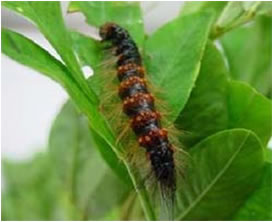 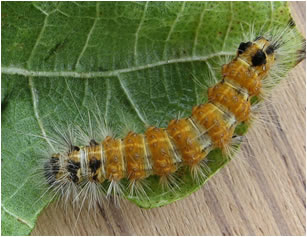 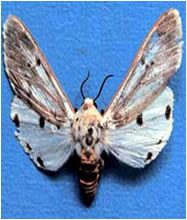 |
| |
| |
Gram pod borer: Helicoverpa armigera
| Parts affected |
Symptoms
|
Management
|
Image
|
| Panicles, leaves and stem |
• Larvae feed on the foliage, prefers flowers and buds.
When tender leaf buds are eaten symmetrical holes or cuttings can be seen upon unfolding of leaflets.
|
Cultural method:
• Deep summer ploughing.
• Adopt Early sowing to escape insect pest damage.
• Irrigate once to avoid prolonged mid season drought
• Planting castor or sunflower plants as trap crop for egg laying and destroy eggs or 1st stage larvae help in reducing the incidence.
• The sunflower act as bird perches as well.
Mechanical method
• Install light trap.
• Take two hand or mechanical weeding at 15-20 days after sowing.
• Use pheromone traps (5/ha) to monitor moth population.
• Install 10-12 bird perches per ha.
• Collect egg masses/early instars larvae from trap crops and kill them.
Biological method
• Conserve the natural enemies namely, spiders, long horned grasshoppers, praying mantis, robar fly, ants, green lace wing, damsel flies/dragon flies, flower bugs, shield bugs, lady bird beetles, ground beetle, predatory cricket, earwig, braconids, trichogrammatids, NPV, green muscular fungus.
• Release of Telenomus remus @ 50000/ha, 4 times (7-10 days interval) based on pheromone trap catching.
• Use SNPV @ 250 LE (6X 109/LE)/ha or B.t. @1 k.g/ha, when large number of egg masses and early instars larvae are noticed.
• Release Trichogramma chilonis @ 50000/ha. 2 times (7-10 days interval) based on on pheromone trap observation.
• Release of Bracon hebetor @ 5000/ha, two times at 7-10 days interval .
• Spray insect pathogenic fungus Nomuraea rileyi @10^13 spores/ha for controlling early instars.
• Release larval parasitoid apanteles africanus @ 5000/ha.
• Use 5% neem seed kernel extract on need basis.
Chemical method
• Apply insecticides only if the insect population crosses the ETL.
• Apply Methyl parathion 2% dust @ 20 kg/ha or spraying of monochrotophos 36 SL or Quinolphos 25 EC @ 1500 ml or Endosulfan 35 EC @1250 ml or Trizophos 40EC @ 800 ml in 700-800 lit of water.
• Poison bait with monocrotophos 36 SL or carbaryl, rice bran, jaggery and water can be used to control the grown up larvae.
|
 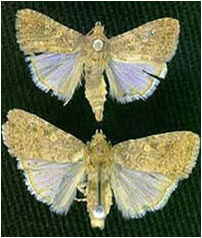 |
| Gram pod borer larva feeding on groundnut and adult |
| |
Rust: Puccinia arachidis
| Parts affected |
Symptoms
|
Management
|
Image
|
| Panicles, leaves and stem |
• Orange coloured pustules (uredinia) appears on the lower surface of leaves and rupture to expose masses of reddish brown urediniospores.
• Pustules appear first on the lower surface and in highly susceptible cultivars the original pustules may be surrounded by colonies of secondary pustules.
• Pustules may also appear on the upper surface of the leaflet.
• The pustules are usually circular and range from 0.5 to 1.4 mm in diameter.
• They may be formed on all aerial plant parts apart from flower and pegs.
• Severely infected leaves turn necrotic and desiccate but are attached to the plant.
|
Cultural method :
• Follow crop rotation and field sanitation.
• Enforcement of strict plant quarantine regulations to avoid the spread of rust on pods or seeds to disease free areas.
• Early sowing in the first fortnight of June avoids this disease incidence.
• Intercropping pearl millet or sorghum with groundnut (1 :3) to reduce the intensity of rust.
• Cultivate resistant/tolerant varieties.
• Destroy volunteer (self sown) groundnut plants and crop debris to reduce / limit primary source of inoculum.
Botanicals:
• Foliar application of aqueous neem leaf extract @ 2-5%.
Chemical method :
• Spray chlorothaalonil 0.2%; or mancozeb 0.25% or Hexaconazole/propaconazole to reduce disease incidence.
|
 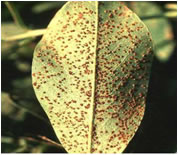 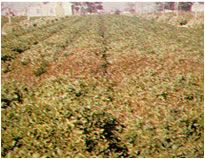 |
| Rust affected leaves with reddish pustules under surface of the leaves and rust affected field |
| |
Late leaf spot: Phaeoisariopsis personatum
| Parts affected |
Symptoms
|
Management
|
Image
|
| Panicles, leaves and stem |
• Infection starts around 55-57 days after sowing in Kharif and 42-46 days after sowing in Rabi.
• Black & nearly circular spots appear on the lower surface of the leaflets.
• Lesions are rough in appearance.
• In severe infestation lesions coalesce resulting into premature senescence and shedding of the leaflets.
|
Cultural method :
• Use of resistant/tolerant varieties wherever late leaf spot is severe.
• Intercropping pearl millet or sorghum with groundnut (1 : 3) to reduce intensity of late leaf spot.
• Crop rotation with non-host crops preferably cereals.
• Deep burying of crop residues in the soil, removal of volunteer groundnut plants to reduce the primary source of infection.
Botanicals :
• Foliar application of aqueous neem leaf extract (2-5%) or 5% neem seed kernel extract at 2 weeks interval 3 times starting from 4 weeks after planting.
Chemical method :
• Spray carbendazim 0.1% or mancozeb 0.2% or chlorothalonil 0.2%. |
  |
| Groundnut leaves affected with late leaf spot |
| |
Rosette virus disease
| Parts affected |
Symptoms
|
Management
|
Image
|
| Panicles, leaves and stem |
• Plants are stunted and present bushy appearance.
• Reduction in size of the leaflets and mottling.
|
• Rogue out infected plants as soon as they appear in the field.
• To check the spread of disease, aphids should be killed by spraying Oxydemeton methyl (Metasystox) 25 EC @ 1 litre dissolved in 1000 litres of water per hectare.
|
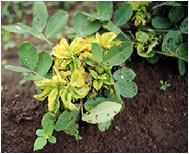  |
| Yellowing, mottling and mosaic symptoms on leaves and stunting and distortion of the shoots |
| |
Charcoal Rot: Macrophomina phaseoli
| Parts affected |
Symptoms
|
Management
|
Image
|
| Panicles, leaves and stem |
• Reddish-brown water-soaked lesion appears on stem just above the soil level.
• The lesion spreads upwards on the stem and down into the roots and causes death of the plants.
• The dead tissue is covered with abundant sclerotia.
|
• Deep ploughing should be followed to bury the crop residues.
• Seed treatment with Thiram @ 5 g per kg of seed.
• Soil application of Brassicol before sowing at the rate of 10-15 kg per hectare.
|
 |
| Charcoal Rot affected root |
| |
Sclerotium Rot or stem rot:Sclerotium rolfsii.
| Parts affected |
Symptoms
|
Management
|
Image
|
| Panicles, leaves and stem |
• The affected plant parts show the development of the white thread-like fungal growth near the soil surface or just below the ground level.
• The affected plant parts later turn brown and small round bodies of about the size of a mustard seed are produced on the surface of affected tissue.
• The leaves turn yellow and then brown and later desiccate.
|
• Collect and burn the affected plant debris.
• Seed treatment with 3% Brassicol.
• Soil application of Brassicol before sowing at the rate of 10-15 kg per hectare.
|
 |
| Sclerotium Rot or stem rot affected plant with white mycelial growth |
| |
Bihar hairy caterpillar: Spilosoma (Diacrisia) obliqua
| Parts affected |
Symptoms
|
Management
|
Image
|
| Panicles, leaves and stem |
• Young larvae feed gregariously, mostly on under surface of the leaves.
• Feed on leaves and cause loss by defoliation.
• In severe cases only stems are left behind.
• It also feed on capsules in defoliated crop.
|
Cultural method :
• Pre-monsoon deep ploughing (two/three times) exposes the hibernating pupae to sunlight and predatory birds.
• Removal and destruction of alternate wild hosts which harbours the hairy caterpillars.
• Grow trap crops like cowpea, castor and jatropha on field bunds to attract the caterpillars.
• Irrigate once to avoid prolonged mid season drought to prevent pre-harvest infestation.
Mechanical method:
• Setting up bonfires on field bunds during night.
• Mass collection and destruction of eggs and just emerged caterpillars.
• Place the twigs and leaves of calotropis, jatropha and papaya around the field to trap grown up caterpillars and destroy them.
Biological method:
• Conserve the natural enemies namely, spiders, long horned grasshoppers, praying mantid, robar fly, ants, green lace wing, damsel flies/dragon flies, flower bugs, shield bugs, lady bird beetles, ground beetle, predatory cricket, earwig, braconids, trichogrammatids, NPV, green muscular fungus.
• Use of NPV (nuclear polyhedrosis virus) on cloudy days at 500 LE/ha.
• Spray Bacillus thuringiensis at 1 kg/ha where mulberry is not grown.
• Conserve the Barconids parasites.
Chemical method :
• Apply insecticides if the insect population crosses the economic threshold level (ETL).
• Dust Lindan 1.3% or Fanvalerate 0.4% 15.20 kg/ha, the early stage is easy to control.
• Form a deep furrow trench around the field and dust with two per cent methyl parathion to prevent the mass migration of hairy caterpillars.
• Spraying of quinalphos 25 EC (2 ml/lit), or chlorpyriphos 20 EC (2.5 ml/lit) or endosulfan 35 EC (2.0 ml/lit) recommended when the caterpillars are younger.
|
    |
| |
| |
Tobacco caterpillar: Spodoptera litura
| Parts affected |
Symptoms
|
Management
|
Image
|
| Panicles, leaves and stem |
• Freshly hatched larvae feed gregariously by scraping the chlorophyll content of leaves and disperse soon.
• Larvae in later stages feed voraciously on the foliage at night, hides in the soil around base of the plants during day time.
• Sometimes the feeding is so heavy that only petioles and branches are left behind.
• In light soil area, caterpillar bores into the pods.
|
Cultural method :
• Deep summer ploughing.
• Early sowing to escape insect pest damage.
• Irrigate once to avoid prolonged mid season drought
• Planting castor or sunflower plants as trap crop for egg laying and destroying eggs or 1st stage larvae help in reducing the incidence.
• The sunflower act as bird perches as well.
Mechanical method:
• Install light trap.
• Two hand or mechanical weeding at 15-20 days after sowing.
• Use pheromone traps (5/ha) to monitor moth population.
• Install 10-12 bird perches per ha.
• Collection of egg masses/early instars larvae from trap crops.
Biological method:
• Conserve the natural bio control population of spiders, long horned grasshoppers, praying mantis, robar fly, ants, greenlace wing, damsel flies/dragon flies, flower bugs, shield bugs, lady bird beetles, ground beetle, predatory cricket, earwig, braconids, trichogrammatids, NPV, green muscular fungus.
• Release of Telenomus remus @ 50000/ha. 4 times (7-10 days interval) based on pheromone trap catching.
• Use SNPV @ 250 LE (6X 10^9/LE)/ha or B.t. @1 k.g/ha, when large number of egg masses and early instars larvae are noticed.
• Release Trichogramma chilonis @ 50000/ha. 2 times (7-10 days interval) based on on pheromone trap observation.
• Release of Bracon hebetor @ 5000/ha. two times at 7-10 days interval .
• Spray insect pathogenic fungus Nomuraea rileyi @10^13 spores/ha for controlling early instars.
• Release larval parasitoid apanteles africanus @ 5000/ha.
• Use 5% neem seed kernel extract on need basis.
Chemical method:
• Apply insecticides if the insect population crosses the economic threshold level (ETL).
• Apply Methyl parathion 2% dust @ 20 kg/ha or spraying of monochrotophos 36 SL or Quinolphos 25 EC @ 1500 ml or Endosulfan 35 EC @1250 ml or Trizophos 40EC @ 800 ml in 700-800 lit of water.
• Poison bait with monocrotophos 36 SL or carbaryl, rice bran, jaggery and water can be used to control the grown up larvae. |
  |
| |
| |
Red Hairy caterpillars: Amsacta albistriga, A. moorei
| Parts affected |
Symptoms
|
Management
|
Image
|
| Panicles, leaves and stem |
• Caterpillars cause defoliation of the crop as they are voracious feeders and often migrate from one field to another devastating whatever crops come their way.
After about 30-40 days of feeding the larvae burrow into soil, usually in the undisturbed soil of field or non-cropped areas and pupate.
|
Cultural method :
• Deep summer ploughing
• After kharif crop, the field should be ploughed to expose the pupae to predatory birds.
• Early sowing is done to escape insect pest damage.
• Plant Inter crop, one row of castor for every 5 or 6 rows of groundnut.
• Follow crop rotation with sorghum/pearl millet or maize.
• Vegetative traps utilising Jatropa (wild castor) or Ipomoea prevent the migration of the grown up larvae across fields.
• Irrigate once to avoid prolonged mid season drought to prevent pre-harvest infestation.
Mechanical method:
• Install of 12 light traps/ha or bonfire in endemic areas.
• Erection of light traps soon after monsoon for 20-45 days and collecting and killing of adult moths are found very effective.
• Collection and destruction of egg masses in the fields around light trap areas.
• Install 10-12 bird perches/ha.
• Two hand or mechanical weeding at 15-20 days after sowing.
Biological method:
• Spray A-NPV (2X 10 5 PIB/I) and Bacillus thuringiensis (Bt).
• Release of Bracon hebetor @ 5000/ha, two times at 7-10 days interval.
• Conserve dominant predators like Coccinella sp. and Minochilus sexmaculata and parasitoids like Chelonus spp.
• Conserve natural enemies namely, spiders, long horned grasshoppers, praying mantis, robar fly, ants, green lace wing, damsel flies/dragon flies, flower bugs, shield bugs, lady bird beetles, ground beetle, predatory cricket, earwig, braconids, trichogrammatids, NPV, green muscular fungus. (2X 105 PIB/I)
• Use 5% neem seed kernel extract on need basis.
• Inter cropping with pigeon pea, mung bean and soybean increases spiders population.
• Population of coccinellids is higher on groundnut with maize, mung bean and soybean and Chrysoperla spp. is higher with maize and soybean intercrops.
Chemical method:
• Apply insecticides if the insect population crosses the economic threshold level (ETL).
• Dusting of Methyl parathion 2% @ 25 to 30 kg/ha or Fanvalerate 0.4% @15-20 Kg/ha.
• Spray Endosulfan 35 EC or Quinalphos 25 EC @ 1250 ml/ha or 500 ml of Nuvan (76%) 4 ml/ha to control full grown insect pests.
|
   |
| |
| |
Gram pod borer: Helicoverpa armigera
| Parts affected |
Symptoms
|
Management
|
Image
|
| Panicles, leaves and stem |
• Larvae feed on the foliage, prefers flowers and buds.
When tender leaf buds are eaten symmetrical holes or cuttings can be seen upon unfolding of leaflets.
|
Cultural method:
• Deep summer ploughing.
• Adopt Early sowing to escape insect pest damage.
• Irrigate once to avoid prolonged mid season drought
• Planting castor or sunflower plants as trap crop for egg laying and destroy eggs or 1st stage larvae help in reducing the incidence.
• The sunflower act as bird perches as well.
Mechanical method
• Install light trap.
• Take two hand or mechanical weeding at 15-20 days after sowing.
• Use pheromone traps (5/ha) to monitor moth population.
• Install 10-12 bird perches per ha.
• Collect egg masses/early instars larvae from trap crops and kill them.
Biological method
• Conserve the natural enemies namely, spiders, long horned grasshoppers, praying mantis, robar fly, ants, green lace wing, damsel flies/dragon flies, flower bugs, shield bugs, lady bird beetles, ground beetle, predatory cricket, earwig, braconids, trichogrammatids, NPV, green muscular fungus.
• Release of Telenomus remus @ 50000/ha, 4 times (7-10 days interval) based on pheromone trap catching.
• Use SNPV @ 250 LE (6X 109/LE)/ha or B.t. @1 k.g/ha, when large number of egg masses and early instars larvae are noticed.
• Release Trichogramma chilonis @ 50000/ha. 2 times (7-10 days interval) based on on pheromone trap observation.
• Release of Bracon hebetor @ 5000/ha, two times at 7-10 days interval .
• Spray insect pathogenic fungus Nomuraea rileyi @10^13 spores/ha for controlling early instars.
• Release larval parasitoid apanteles africanus @ 5000/ha.
• Use 5% neem seed kernel extract on need basis.
Chemical method
• Apply insecticides only if the insect population crosses the ETL.
• Apply Methyl parathion 2% dust @ 20 kg/ha or spraying of monochrotophos 36 SL or Quinolphos 25 EC @ 1500 ml or Endosulfan 35 EC @1250 ml or Trizophos 40EC @ 800 ml in 700-800 lit of water.
• Poison bait with monocrotophos 36 SL or carbaryl, rice bran, jaggery and water can be used to control the grown up larvae.
|
  |
| Gram pod borer larva feeding on groundnut and adult |
| |
Rust: Puccinia arachidis
| Parts affected |
Symptoms
|
Management
|
Image
|
| Panicles, leaves and stem |
• Orange coloured pustules (uredinia) appears on the lower surface of leaves and rupture to expose masses of reddish brown urediniospores.
• Pustules appear first on the lower surface and in highly susceptible cultivars the original pustules may be surrounded by colonies of secondary pustules.
• Pustules may also appear on the upper surface of the leaflet.
• The pustules are usually circular and range from 0.5 to 1.4 mm in diameter.
• They may be formed on all aerial plant parts apart from flower and pegs.
• Severely infected leaves turn necrotic and desiccate but are attached to the plant.
|
Cultural method :
• Follow crop rotation and field sanitation.
• Enforcement of strict plant quarantine regulations to avoid the spread of rust on pods or seeds to disease free areas.
• Early sowing in the first fortnight of June avoids this disease incidence.
• Intercropping pearl millet or sorghum with groundnut (1 :3) to reduce the intensity of rust.
• Cultivate resistant/tolerant varieties.
• Destroy volunteer (self sown) groundnut plants and crop debris to reduce / limit primary source of inoculum.
Botanicals:
• Foliar application of aqueous neem leaf extract @ 2-5%.
Chemical method :
• Spray chlorothaalonil 0.2%; or mancozeb 0.25% or Hexaconazole/propaconazole to reduce disease incidence.
|
   |
| Rust affected leaves with reddish pustules under surface of the leaves and rust affected field |
| |
Late leaf spot: Phaeoisariopsis personatum
| Parts affected |
Symptoms
|
Management
|
Image
|
| Panicles, leaves and stem |
• Infection starts around 55-57 days after sowing in Kharif and 42-46 days after sowing in Rabi.
• Black & nearly circular spots appear on the lower surface of the leaflets.
• Lesions are rough in appearance.
• In severe infestation lesions coalesce resulting into premature senescence and shedding of the leaflets.
|
Cultural method :
• Use of resistant/tolerant varieties wherever late leaf spot is severe.
• Intercropping pearl millet or sorghum with groundnut (1 : 3) to reduce intensity of late leaf spot.
• Crop rotation with non-host crops preferably cereals.
• Deep burying of crop residues in the soil, removal of volunteer groundnut plants to reduce the primary source of infection.
Botanicals :
• Foliar application of aqueous neem leaf extract (2-5%) or 5% neem seed kernel extract at 2 weeks interval 3 times starting from 4 weeks after planting.
Chemical method :
• Spray carbendazim 0.1% or mancozeb 0.2% or chlorothalonil 0.2%. |
  |
| Groundnut leaves affected with late leaf spot |
| |
Rosette virus disease
| Parts affected |
Symptoms
|
Management
|
Image
|
| Panicles, leaves and stem |
• Plants are stunted and present bushy appearance.
• Reduction in size of the leaflets and mottling.
|
• Rogue out infected plants as soon as they appear in the field.
• To check the spread of disease, aphids should be killed by spraying Oxydemeton methyl (Metasystox) 25 EC @ 1 litre dissolved in 1000 litres of water per hectare.
|
  |
| Yellowing, mottling and mosaic symptoms on leaves and stunting and distortion of the shoots |
| |
Charcoal Rot: Macrophomina phaseoli
| Parts affected |
Symptoms
|
Management
|
Image
|
| Panicles, leaves and stem |
• Reddish-brown water-soaked lesion appears on stem just above the soil level.
• The lesion spreads upwards on the stem and down into the roots and causes death of the plants.
• The dead tissue is covered with abundant sclerotia.
|
• Deep ploughing should be followed to bury the crop residues.
• Seed treatment with Thiram @ 5 g per kg of seed.
• Soil application of Brassicol before sowing at the rate of 10-15 kg per hectare.
|
 |
| Charcoal Rot affected root |
| |
Sclerotium Rot or stem rot:Sclerotium rolfsii.
| Parts affected |
Symptoms
|
Management
|
Image
|
| Panicles, leaves and stem |
• The affected plant parts show the development of the white thread-like fungal growth near the soil surface or just below the ground level.
• The affected plant parts later turn brown and small round bodies of about the size of a mustard seed are produced on the surface of affected tissue.
• The leaves turn yellow and then brown and later desiccate.
|
• Collect and burn the affected plant debris.
• Seed treatment with 3% Brassicol.
• Soil application of Brassicol before sowing at the rate of 10-15 kg per hectare.
|
 |
| Sclerotium Rot or stem rot affected plant with white mycelial growth |
| |
| 3. Pod development to maturity |
Root and Pod feeders White grubs : Holotrichia consanguinea, Holotrichia serrata
| Parts affected |
Symptoms
|
Management
|
Image
|
| Panicles, leaves and stem |
• Both adults and larvae are damaging stage.
• The larvae feeds roots and damage pods.
• Grubs feed on fine rootlets, resulting in pale, wilted plants dying in patches.
|
Cultural method:
• Deep summer ploughing.
• Always use well decomposed organic manure it attracts the adult beetles.
• Partial or complete lopping of host plants and retaining of a few most preferred host trees in the area for congregation of white grub adults.
• Follow crop rotation with sorghum/pearl millet or maize.
• Adopt Early sowing to avoid damage due to insect pest.
• Standing crops of fodder, sugarcane etc. are also protected.
Mechanical method
•Collection and destruction of white grub adults from host trees around the field.
Biological method
• Conserve braconids, dragon flies, trichogrammatids, NPV, green muscardine fungus.
Chemical method
• Apply insecticides if the insect population crosses the economic threshold level (ETL).
• Spray should be undertaken as a community approach and should be repeated after every rainfall till the middle of July.
• Spraying the trees close to the field with Chlorpyriphos 20 EC @ 2 ml/lit of water soon after first monsoon showers for 3-4 days in the late evening hours kills the adult beetles and reduces root grub infestation.
• Seed treatment with chlorpyriphos 20 EC ( 6.5 to 12.5 ml/kg seed) is found effective.
• In case of severe infestation apply 10% phorate @ 10 kg/ha.
|
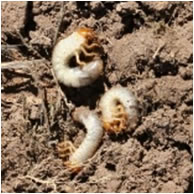 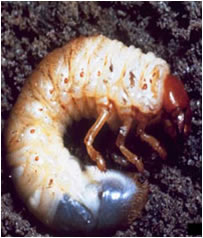  |
| Grubs and adult of root grub |
| |
Pod borer, Anisolabis stalli
| Parts affected |
Symptoms
|
Management
|
Image
|
| Panicles, leaves and stem |
• Young pods showing bore holes plugged with excreta.
• Sand particles or discoloured pulps.
• Pods without kernal.
|
• Apply any one of the following to the soil prior to sowing in endemic areas: malathion 5 D 25 kg/ha, endosulfan 4 D 25 kg/ha
• Repeat soil application of any one of the above dust formulations on the 40th day of sowing and incorporate in the soil during the earthing up.
|
|
| |
| |
Pod bug: Elasmolomus (=Aphanus )sordidus
| Parts affected |
Symptoms
|
Management
|
Image
|
| Panicles, leaves and stem |
• Freshly harvested pods having shriveled kernels
|
• Apply any one of the following to the soil prior to sowing in endemic areas malathion 5 D 25 kg/ha, endosulfan 4 D 25 kg/ha
• Repeat soil application of any one of the above dust formulations on the 40th day of sowing and incorporate in the soil during the earthing up
|
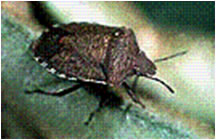 |
| |
| |
Termites: Odontotermes spp
| Parts affected |
Symptoms
|
Management
|
Image
|
| Panicles, leaves and stem |
• Wilting of plants in patches
• Termites penetrate and hollow out the tap root and stem thus kill the plant.
• Bore holes into pods and damage the seed.
• It removes the soft corky tissue from between the veins of pods causing scarification, weaken the shells, make them liable to entry and growth of Aspergillus flavus that produces aflotoxins.
|
Cultural method:
• Digging the termitaria (termite mound) and kill the queen is most important in termite management.
• Use well rotten organic manure.
• Harvest the groundnuts as soon as they are matured, early removal of the produce from the field will reduce the chances of termite damage to pods.
• Maintain clean cultivation or field sanitation.
• Irrigate the crop frequently.
Mechanical method
•Thorough ploughing and carry out frequent intercultural operation.
• Avoid physical loss of the crop during harvesting.
• Destruction of debris, termite nests and queen.
Chemical method
• Apply safe chemical insecticides at recommended doses only if the insect population crosses the ETL.
• Apply chlorpyriphos 20 EC or Lindane 1.3% to control termites or apply dust of chlorpyriphos @ 30-40 kg/ha in soil before sowing.
• Seed dressing with insecticides such as 6.5ml of chloropyriphos /kg of seed reduces termite damage.
|
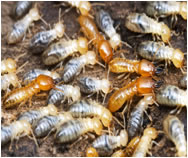 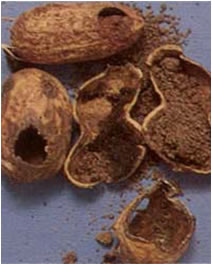 |
| Termits and affected pods filled with soil |
| |
Jewel beetle (Sphenoptera indica)
| Parts affected |
Symptoms
|
Management
|
Image
|
| Panicles, leaves and stem |
• The grub burrows into the stem, close to the soil surface and kills the plant.
• Infested fields show dead and dying plants, which when pulled up and examined grub/pupa can be seen in hollowed stem.
|
Cultural method:
• Grow tolerant varieties.
• Adopt deep summer ploughing.
• Use well decomposed organic manure.
Mechanical method
• Collection and destruction of infested plants.
Biological method
• Conserve braconids, dragon flies, trichogrammatids, NPV, green muscardine fungus
Chemical method
• Apply insecticides if the insect population crosses the economic threshold level (ETL).
• Apply carbofuran granules in the planting row as prophyylactic measure.
• Apply Carbofuran 2.25 kg active ingredient per hectare.
|
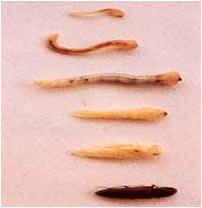 |
| Grubs and adult of jewel beetle |
| |
Rust: Puccinia arachidis
| Parts affected |
Symptoms
|
Management
|
Image
|
| Panicles, leaves and stem |
• Orange coloured pustules (uredinia) appears on the lower surface of leaves and rupture to expose masses of reddish brown urediniospores.
• Pustules appear first on the lower surface and in highly susceptible cultivars the original pustules may be surrounded by colonies of secondary pustules.
• Pustules may also appear on the upper surface of the leaflet.
• The pustules are usually circular and range from 0.5 to 1.4 mm in diameter.
• They may be formed on all aerial plant parts apart from flower and pegs.
• Severely infected leaves turn necrotic and desiccate but are attached to the plant.
|
Cultural method :
• Follow crop rotation and field sanitation.
• Enforcement of strict plant quarantine regulations to avoid the spread of rust on pods or seeds to disease free areas.
• Early sowing in the first fortnight of June avoids this disease incidence.
• Intercropping pearl millet or sorghum with groundnut (1 :3) to reduce the intensity of rust.
• Cultivate resistant/tolerant varieties.
• Destroy volunteer (self sown) groundnut plants and crop debris to reduce / limit primary source of inoculum.
Botanicals:
• Foliar application of aqueous neem leaf extract @ 2-5%.
Chemical method :
• Spray chlorothaalonil 0.2%; or mancozeb 0.25% or Hexaconazole/propaconazole to reduce disease incidence.
|
   |
| Rust affected leaves with reddish pustules under surface of the leaves and rust affected field |
| |
Late leaf spot: Phaeoisariopsis personatum
| Parts affected |
Symptoms
|
Management
|
Image
|
| Panicles, leaves and stem |
• Infection starts around 55-57 days after sowing in Kharif and 42-46 days after sowing in Rabi.
• Black & nearly circular spots appear on the lower surface of the leaflets.
• Lesions are rough in appearance.
• In severe infestation lesions coalesce resulting into premature senescence and shedding of the leaflets.
|
Cultural method :
• Use of resistant/tolerant varieties wherever late leaf spot is severe.
• Intercropping pearl millet or sorghum with groundnut (1 : 3) to reduce intensity of late leaf spot.
• Crop rotation with non-host crops preferably cereals.
• Deep burying of crop residues in the soil, removal of volunteer groundnut plants to reduce the primary source of infection.
Botanicals :
• Foliar application of aqueous neem leaf extract (2-5%) or 5% neem seed kernel extract at 2 weeks interval 3 times starting from 4 weeks after planting.
Chemical method :
• Spray carbendazim 0.1% or mancozeb 0.2% or chlorothalonil 0.2%. |
  |
| Groundnut leaves affected with late leaf spot |
| |
Groundnut bruchid
| Parts affected |
Symptoms
|
Management
|
Image
|
| Panicles, leaves and stem |
• The larva burrows through the pod wall and starts eating the seed.
• The damage can be diagnosed by the appearance of "windows" on the pod wall made by the grub before pupation, to facilitate adult emergence.
|
Cultural Control:
• Dry the pods to optimum kernel moisture level of about 7 %.
• Store the pods in polythene-lined gunny bags and fill the top surface of the bag with a layer of 3 cm ht. sand.
• Mouth of bags should not be stitched or closed to avoid germination loss.
• Care should be taken to avoid breakage.
• Avoid storing of broken seeds for long periods.
• Dust an inert substance such as ABCD (attapulgite-based clay dust)
Chemical Control:
• Apply insecticides if the insect population crosses the economic threshold level (ETL).
• Pods mixed with ABC (Attapulgite based clay) dust (5 g/kg pods) remain free from bruchid infestation for one year.
• Pods for seed purpose can be treated with thiram (3 g/kg pods) and kept free from infestation for one year.
• Celphos fumigation (3 g tablet per sack of groundnut (40 kg)).
|
|
| |
| |

Agro Advisory Service
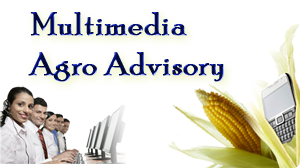
| 























































































![]()
